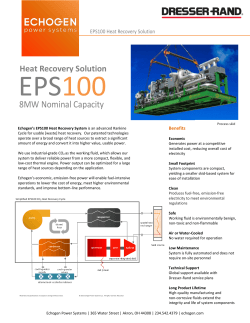
slides - organized by CO 2 GeoNet in collaboration with
Providing assurance of storage capacity in open connected aquifers for multiple users: a case study from the Moray Firth – Scottish CCS, SiteChar and objectives of the CO2MultiStore projects Maxine Akhurst British Geological Survey and SCCS EERA-CO2GeoNet workshop, San Servolo Island, Italy 13 May 2015 © NERC All rights reserved Summary findings Lessons learned • • • • • • • Can either inject CO2 at multiple sites or achieve a high and continuous injection rate by managing pressure A hydraulically connected formation needs regional-scale appraisal Knowledge of boundary conditions is key information Greater storage capacity by CO2 injection into a depleted field than injection directly into the surrounding aquifer The cost and effort to access and interpret existing data is worth it Can achieve a first-pass storage site assessment in a hydrocarbon province from existing publicly available and published data Characterisation should be guided by views by operators & regulators Knowledge gaps • Knowledge of the existing datasets and their availability • Understanding of the effect of prospective storage operations on existing storage formation users 2 © NERC All rights reserved Theoretical storage capacity UK central & northern North Sea Suitable basins are all offshore • Central & northern North Sea (blue) • Depleted oil and gas fields • Saline aquifer sandstones • Shortlist of 10 sandstones Geological characteristics Acceptable - orange Optimal – green 29 suitable oil & gas fields - grey • www.sccs.org.uk/expertise/reports.html Opportunities for CO2 Storage around Scotland 3 © NERC All rights reserved Theoretical storage capacity (2008) • Depleted fields ~1 300 million tonnes (Mt) • Sandstones > 4 600 Mt Theoretical storage capacity – UK central & northern North Sea • Shortlisted saline aquifer sandstones • Very large extent, 1 700 to 17 000 km2 • Many are overlapping • Geological character is well known where they include hydrocarbon fields but less well known where brine saturated • Storage efficiency assumed to be 0.2% to 2.0% of pore volume • Total storage capacity for all 10 aquifers is wide ranging • 4 600 to 46 000 million tonnes • Selection of a sandstone for CO2 storage research 4 © NERC All rights reserved Sandstone extents from UKOOA www.sccs.org.uk/expertise/reports.html Progressing Scotland’s CO2 storage opportunities Captain Sandstone – criteria for selection Non-geological criteria • Proximity to CO2 sources; • Proximity to existing infrastructure, such as oil and gas pipelines; • Presence of hydrocarbon field data • Data availability Geological criteria • Depth <800 to >2000 m • Permeability, mean 2000 mD (100 to 10 000 mD) • Porosity, mean 30% (20-40%) • Theoretical storage capacity 36-363 Mt CO2 Two demonstrator CCS projects propose to store in the Captain Sandstone 5 © NERC All rights reserved www.sccs.org.uk/expertise/reports.html Progressing Scotland’s CO2 storage opportunities Captain Sandstone – storage research • • • • Revised mapping of the sandstone 3D geological model Attribute model cells with sandstone properties Selection of injection wells positions for dynamic modelling with constraints: • Retain CO2 >800 m depth • Avoid localised increases in pressure • Avoid oil and gas fields www.sccs.org.uk/expertise/reports.html Progressing Scotland's CO2 storage opportunities 6 © NERC All rights reserved Captain Sandstone – dynamic capacity • Tested 12 well sites. • • • • Jin et al., 2012, Society Petroleum Engineers, 154539 • • • • 7 Simulated injection of 2.5 Mt CO2 per year Constrained to a maximum 1.3 x initial pressure After 10 years injection the rate at all sites was < 2.5 Mt After 50 years injection at only the deepest well site Storage capacity of at least 358 Mt, theoretical maximum, up to 1.5 Gt Captain Sandstone is a single hydraulically connected storage unit Properties of the sandstone boundaries need to be understood Pressure needs to be managed to maximise the potential storage capacity © NERC All rights reserved www.sccs.org.uk/expertise/reports.html Progressing Scotland's CO2 storage opportunities SiteChar project Characterisation of European CO2 storage www.sitechar-co2.eu 8 © NERC All rights reserved Captain Sandstone - storage site characterisation www.sitechar-co2.eu Workflow for site characterisation tested at 5 sites Assessment of a UK storage site, comprising • A depleted hydrocarbon field: early storage capability; • The surrounding Captain Sandstone saline aquifer: greater storage potential, later in the storage cycle. Objectives • Site characterisation sufficient for a ‘dry-run’ storage permit application • Targeted to increase certainty and confidence in the storage resource Injection scenario • Continuous supply and ‘commercial-scale’ storage of 5 Mt CO2 per year for 20 years – 100 Mt stored at a single injection site 9 © NERC All rights reserved Captain Sandstone - storage site characterisation • Selected the Blake Field as a component of the store • Modelled the site from high resolution 3D data • Integrated into the regional geological model • Mapped and attributed the geocellular model by facies Channel and Flank e.g. porosity • Stochastic modelling honours statistical distribution from core measurements • Average values from well data www.sitechar-co2.eu 10 © NERC All rights reserved SiteChar - characterisation of a feasible site and credible injection scenario • • • • • • 11 Simulated injection of CO2 into the Blake Field and into the Captain Sandstone saline aquifer 20 years of injection & 30 years post-injection In all scenarios: • Injected CO2 gas was retained within the hydrocarbon field or immediate vicinity • Pressure ‘footprint’ was extensive • At this injection rate simulations indicated pressure management is needed Pressure management by water production was simulated Hydrocarbon fields are not adversely effected Pressure managed to remain substantially less (1/3) the modelled pressure threshold Akhurst et al., accepted for publication, Oil & Gas Science and Technology Review © NERC All rights reserved Overpressure – 1 year injec,on 5 years injec,on 20 years injec,on 30 years rest CO2MultiStore - optimising storage potential by multi-user stores • • • • • • 12 Informs development of multiple injection sites in a single extensive CO2 storage sandstone Investigations follow SiteChar workflow Addresses: • Increased certainty for development of multiple injection sites hosted within a multi-user storage sandstone • Potential interactions between injection sites Informs the licensing and leasing of multi-user stores to optimise storage capacity Supported by the Scottish Government, The Crown Estate, Scottish Enterprise, Shell and Vattenfall Captures generic knowledge learned during the project transferable to other regional storage formations © NERC All rights reserved Lessons learned Scottish CCS studies • Can inject CO2 at multiple sites and sustain store integrity • Can manage pressure by varying or reducing injection rate • Dynamic modelling supports the maximum theoretical storage capacity • A single hydraulically connected formation needs regional-scale appraisal • Knowledge of boundary conditions is key information – for increased confidence in pressure prediction and storage capacity SiteChar • Can achieve a high and continuous injection rate to store 100 Mt at a single site by managing pressure, with water production • CO2 injection into a depleted field generates a lower pressure anomaly than injection directly into the surrounding aquifer with greater storage capacity • The cost and effort to access and interpret existing data is worth it - greater confidence in prediction of store site performance • Can achieve pre-characterisation for a first-pass storage site assessment in a hydrocarbon province from existing publicly available and published data 13 © NERC All rights reserved Lessons learned • Perspective of prospective operators and regulators guides what would be needed to give sufficient understanding and confidence for a storage permit Scottish CCS and SiteChar studies • Increased understanding of the storage formation has not been associated with an expected decrease in storage capacity - regional dynamic modelling at twelve injection sites (358 Mt) supports at least the previous theoretical maximum capacity (363 Mt) and more - site-specific modelling indicates roughly one third of the minimum capacity from dynamic modelling can be stored at a single site CO2MultiStore • Work in progress, findings announced Summer 2015 • Great benefit to have access to industry-derived storage site investigations, published data from the prospective UK demonstrator • Integration of the views of prospective operators, regulators and lease holders to guide investigations substantially increases confidence in the practical operation of a multi-user store 14 © NERC All rights reserved Knowledge gaps • Knowledge of the existing datasets and availability: • Maps or indexes of all data collected for other purposes • Detailed data against which to validate and confirm/ revise our model attribution and performance predictions • How to access data • Access to data which is known to have been collected but not publicly available • Understand the effect of prospective storage operations on existing storage formation users • Are predicted changes beneficial or not? • Anticipate & mitigate potentially adverse effects • Plan & manage beneficial effects 15 © NERC All rights reserved
© Copyright 2025












